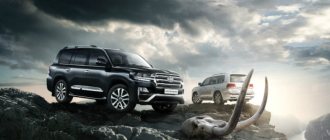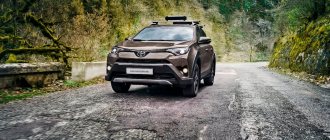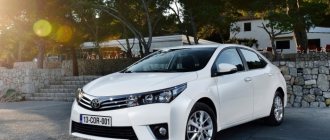The 2021 model year Toyota Corolla passenger car belongs to the modernized E170 generation, which lasted on the concern’s conveyors until 2021.
The cars were delivered to Russian customers with a sedan body and several options of gasoline engines. Basic modifications were equipped with a manual transmission, while expensive versions were equipped with a continuously variable automatic transmission with the function of selecting additional operating modes.
What changes have been made
Major adjustments introduced during the modernization process:
- changing the design and construction of lighting equipment;
- the use of an improved fuel supply system that does not allow liquid to drain into the tank during long periods of inactivity;
- modification of door frames and reinforcements;
- introduction of new finishing materials;
- use of front fog lights with a modified configuration;
- modification of the wheel rims, which reduced the amount of adhering dirt;
- use of the ERA-GLONASS emergency communication system with an external antenna;
- introduction of a color information display in the instrument cluster;
- expansion of the list of security systems (for example, the plant began to offer a module for monitoring road markings for some markets).
Exterior of Toyota Corolla 2017
Externally, the car is distinguished by plastic bumpers with a modified configuration and LED front optics (optional, standard halogen lamps are used in the base) with daytime running lights.
The front bumper is pushed forward and equipped with chrome trim, emphasizing the swiftness of the silhouette.
The taillights received aerodynamic protrusions to prevent surface contamination; The design of aluminum wheels has changed.
Body
The car has retained the same 4-door all-metal monocoque body, which has programmable deformation zones. The interior frame is made of alloy steel, providing protection for passengers in frontal or side impacts.
Upon impact, the power unit goes down without deforming the engine shield and without causing injury to the legs of the driver and passenger.
The luggage compartment is located in the rear of the body, the layout and capacity have not changed compared to early E170 series cars.
Appearance of the new model
The main changes to the Corolla of the new model year affected its exterior. First of all, the body, which, although it remained quite recognizable, still received additional curves and sharp lines. The result was a completely futuristic design at the same time as a sporty style, allowing the car to look modern and stylish.
Looking at the front of the model, we can note such innovations as narrowed and noticeably elongated headlights with built-in LED matrices. A special feature of the headlights is the function of automatically switching lighting options - from low to high and vice versa. The radiator grille with the Toyota badge emphasizes the design of the hood, reminiscent of the beak of a bird of prey, and the front bumper has a wide air intake and niches for round foglights.
The roof of the car with the new body received a slight slope towards the rear, where a careful eye can easily notice the updated headlights with LED filling and partial location on the trunk lid. And the enlarged bumper has a wide recess, which makes access to the trunk easier. Here, in the lower part of the car, there is a plastic lining in which niches are located for the exhaust system pipes.
The increased dimensions of the wheel arches make it possible to install wheels with a diameter of 16 and 17 inches. While a complete update of the body improves the aerodynamics of the vehicle, which owners of previous Corolla models were dissatisfied with. This is precisely the goal that Japanese developers achieved by creating one of the best restylings of the model in recent years.
Car interior
The instrument panel installed in the cabin has a top pad made of foamed plastic with a soft structure. In front of the driver is an analog instrument cluster with a display.
The factory has used a keyless entry system (available on some models), but unlocking sensors are installed only on the front doors. Not all possible options were offered for the Russian market, so the interior has a large number of plastic plugs for buttons or switches.
The radio used in the maximum configuration is equipped with a 7″ diagonal color touch screen; on the side of the display there is a digital clock standard for Corolla.
To control the functions of the multimedia center and on-board computer, buttons located on the steering wheel spokes are used.
Under the radio there is a climate control unit with an additional display and seat heating control buttons. The socket and USB port are located in the pocket in front of the gearbox control knob.
The rear row of seats is equipped with a backrest with an integrated folding armrest, which provides nests for glasses with drinks. The factory kept the body floor behind the front seats flat and the roof slope high, which leaves plenty of headroom for passengers.
An additional socket is provided. Heated or cooled air is supplied to the rear of the cabin through ducts located under the front seats (there are no air ducts on the rear wall of the center console).
Car salon
The interior of the 2021 Toyota Corolla in the new body has also undergone significant changes, which is already noticeable by the high quality of finishing materials - wear-resistant leather or durable fabric. In the maximum configuration, the model received a 4-inch router, a multifunction steering wheel and a modern multimedia system with a 7-inch diagonal touch display.
And also an improved version of climate control with a black and white screen for controlling the system. As additional options, you can order a heated steering wheel, satellite navigation, the ability to open the door and access the interior without a key.
The basic version of the model received a far less expensive interior and steering wheel functionality, a rather modest dashboard in terms of capabilities, and a regular air conditioner. In addition, the owner of such a car will only be able to use a simplified version of the multimedia system. Although the body and excellent sound insulation remain the same for any modification.
Specifications
In-line 4-cylinder engines are equipped with 16-valve cylinder heads with 2 camshafts equipped with a Dual VVT-i timing control system.
The gas distribution mechanism has a chain drive, fuel is supplied by injectors of a multipoint injection system (turbochargers are not provided).
The power units have forced liquid cooling and comply with Euro-5 standards. For Europe and the USA, a modification with a hybrid installation was offered, but the car is not certified for Russia.
The cars used 6-speed manual transmissions or a Multidrive S V-belt variator (optional for a 1.6-liter engine and default when installing a 1.8-liter engine).
Torque was transmitted to the front wheels by axle shafts equipped with vibration dampers that occurred during rotation. Cars for the Russian market used a washer fluid reservoir with an increased volume, but no nozzles equipped with electrical heating.
Cars supplied to the Russian Federation are distinguished by reinforced springs and shock absorbers, which increase ground clearance to 150 mm. The front suspension uses MacPherson struts, while the rear retains a torsion beam.
The brake system is hydraulic type with disc mechanisms on all wheels (ventilated elements are used at the front). The parking brake with a control lever acts on the standard pads of the rear mechanisms.
Main parameters and dimensions of the car:
- body length - 4639 mm;
- wheelbase - 2700 mm;
- width (with mirrors removed) - 1776 mm;
- height - 1455 mm;
- curb weight - up to 1275 kg;
- permissible total weight - up to 1785 kg;
- Luggage compartment capacity - 452 l;
- Fuel tank capacity - 55 l.
Vehicle handling
The steering is equipped with a rack and pinion mechanism with an electric booster that monitors the speed of movement (as the vehicle accelerates, the gain decreases).
When you turn the steering wheel, the car smoothly changes its trajectory without provoking the driver to take the turn at speed. The soft suspension smooths out uneven road surfaces, but with a sharp change in the trajectory of movement, the body tilts towards the turn.
News
The latest news regarding the car suggests that people all over the world are eagerly awaiting its release. An advertising campaign was carried out telling about the mass of advantages inherent in this vehicle, which naturally resulted in the desire of buyers to quickly ride this car.
Among the news you can also highlight the fact about the test drive. Toyota Corolla was tested in different road conditions. Considering that the sedan is designed for driving within city limits, the car performed quite well off-road. Excellent handling at high speed was also noted. At high speeds, the cabin remains quiet.
Testers were pleased with the quality of the power steering wheel. It allows you to take the tightest turns without any effort at all. Automatic high beam adjustment allows you to avoid blinding oncoming drivers.
Security systems
The list of security systems on the Corolla E170 included:
- Separate brake drive circuit with an ABS unit that distributes forces depending on the load and supports the uphill start and trajectory stabilization systems.
- TRC traction control system, which distributes the power flow between the drive wheels when driving on slippery roads or loose soil.
- Airbags installed in the instrument panel (including the knee element), front seat backrests and body pillars. When installing a child seat, the front passenger's front airbag is switched off manually (there is a control indicator on the instrument panel). Additional Isofix mounts are provided on the rear seat.
- Safety bars located inside the doors (designed to soften side impacts).
- System for forced activation of the hazard warning lights when the speed decreases sharply or when the airbags are deployed.
Options and prices of Toyota Corolla 2021
Equipment options and prices for E170 cars at the beginning of 2017:
- “Standard” (from 1.03 million rubles);
- “Classic” (from 1.146 million rubles);
- “Style” (from RUB 1.217 million);
- “Comfort” (from 1.263 million rubles);
- “Style Plus” (from RUB 1.317 million);
- “Prestige” (from 1.404 million rubles).
Standard equipment included:
- external plastic trim elements painted in the main body color;
- turn direction repeaters integrated into the rear-view mirror housings;
- support for head light switch-off delay function;
- electric heating and adjustment of rear-view mirrors;
- frontal airbags;
- ABS unit in the brake drive with support for the BAS emergency speed reduction function;
- electronic immobilizer and central locking with a control panel installed in the ignition key;
- heated rear window with auto-off timer;
- mechanical adjustment of the front seats (the driver's seat is height adjustable);
- front armrest with storage box for small items.
"Standard"
The basic modification was equipped only with a 99-horsepower 1.3-liter 1NR-FE gasoline engine and a 6-speed manual transmission, which reduced fuel consumption in suburban mode to 4.7 liters per 100 km.
The steering column is adjustable in 2 directions, manual air conditioning and heated seats for the front passenger and driver are installed. The rear sofa is equipped with a separate backrest, but there is no radio (the factory installed only 4 speakers at the bottom of the doors).
"Classic"
The “Classic” version was distinguished by the introduction of side airbags and a 122-horsepower 1.6-liter 1ZR-FE engine, which could work with either a 6-speed manual transmission or a continuously variable transmission.
The interior retained the fabric trim of the seats; the radio was installed by the factory as a separate order. The “Standard” and “Classic” modifications were equipped with stamped wheel rims with decorative plastic caps (tire size - 195/65R15).
"Style"
On the “Style” modification, front fog lights of a round configuration were installed, and the steering wheel and handbrake lever were trimmed with artificial leather.
Electric window lifters were used on the rear doors (manual mechanisms were used on previous modifications).
A radio with an additional USB connector was included in the standard equipment; externally, the car was distinguished by the installation of alloy wheels with tires measuring 205/55R16.
"Comfort"
Starting with the “Comfort” version, the plant installed LED rear lighting equipment, and the instrument cluster used a rectangular color display with a diagonal of 4.2″ (on previous trim levels - “Standard”, “Classic” and “Style” - an instrument cluster with a monochrome screen was used) . The cars were equipped with curtain airbags, a hill start assistant and a stability control unit.
"Style Plus"
The “Style Plus” modification introduced headlights with LEDs for both low and high beam. To maintain the temperature inside the cabin, a 2-zone climate control system with separate controls and an air filter to remove dust and unpleasant odors was used.
In addition to the parking assistant with ultrasonic sensors, a rear view camera is installed that displays an image on the 7″ diagonal radio screen. The buyer could order the installation of a 140-horsepower 1.8-liter 2ZR-FE engine.
"Prestige"
The “Prestige” version was offered only with the 2ZR-FE engine and a continuously variable transmission. Instead of a standard ignition switch, a keyless entry system with a start and stop button for the power unit was installed.
Parking sensors were installed in the front and rear bumpers, an additional mechanism for electric folding of the rear-view mirror housings was added, and there were water and light sensors on the windshield (to automate the operation of the windshield wipers and the external lighting system).
Car competitors
Toyota Corolla's competitors in 2021 were:
- Ford Focus, equipped with hatchback, sedan or station wagon body styles. The cars were equipped with gasoline and diesel engines, working in conjunction with a manual or automatic transmission. Since 2021, due to a change in Ford's policy, assembly and sale of the model on the Russian market has been stopped.
- Hyundai Elantra 6th generation (manufactured since 2015). In the Russian Federation, versions with gasoline engines with a capacity of 128 and 150 hp were offered. With. The car has an identical wheelbase (2700 mm) and comparable interior dimensions. The advantages of the South Korean concern's products were a reduced price and an increased list of options.
- Honda Civic, equipped with a naturally aspirated 158-horsepower engine with a continuously variable CVT gearbox or a 6-speed manual transmission. The car is designed for people who prefer a dynamic driving style. There was an improved modification with a 174 hp engine. s., equipped with a turbocharger.
- Renault Fluence, offered with 1.6 or 2.0 liter gasoline engines (power from 106 to 138 hp). In addition to the manual transmission, a continuously variable transmission and automatic transmission were used.
- Skoda Octavia A7 with naturally aspirated or supercharged gasoline engines, working with a manual gearbox or DSG preselective transmission.
Advantages and disadvantages
Main advantages of the car:
- good maneuverability;
- comfortable interior;
- bright light from head optics;
- low fuel consumption;
- the presence of a variator with a modified operating algorithm.
Disadvantages of the car noted by the owners:
- poor factory sound insulation of doors and wheel arches;
- long-term heating of the interior in winter;
- fogging of the upper part of the glass in the doors at air temperatures below -25°C;
- lack of ignition switch illumination;
- ceiling lining, damaged even by soft objects;
- insufficient ground clearance.
Where to buy?
If we are talking directly about the Russian Federation, then the car can be bought at all official showrooms cooperating with Toyota. It is noteworthy that the car will be sold in major cities, including Moscow, St. Petersburg, Krasnodar and many others. By the way, photos of the car are freely available, and therefore anyone can familiarize themselves with them.
Reviews from car owners
Dmitry, 35 years old, Krasnodar
I purchased a Corolla car from a car dealership in mid-2021. Over 3 years of operation, the car covered 120 thousand km without repairing the chassis.
I carry out maintenance at an authorized dealer every 10 thousand km. The disadvantage of the model is poor sound insulation: the impact of sand and stones on the wheel arch liners and the bottom can be heard in the cabin.
At 60 thousand km, under warranty, the coolant pump was replaced (the cause of the breakdown was a bearing that had worn out prematurely due to a manufacturing defect).
Konstantin, 31 years old, St. Petersburg
For 2 years I drove a Corolla company car with a manual transmission. The mileage was 60 thousand km. The dimensions of the body made it possible to maneuver in cramped conditions.
The power of the 1.6 liter engine was enough to move around the city at a calm pace. On a fully loaded highway, the dynamics dropped, but overtaking trucks or buses is not a problem.
Among the winter options on the car was a heated steering wheel and windshield wiper stop zone. There was a lack of full-fledged electric heating of the windshield.
Start of sales
As already mentioned, the start of sales in Western European countries is scheduled for the summer of 2021. If nothing supernatural happens, then soon you will be able to see this car on the roads in European countries.
As for information about the start of sales in Russia, we will have to wait a little. Official representatives of the Japanese company announced this process for the first half of 2021. Given the unstable economic situation, the exact date may change.











